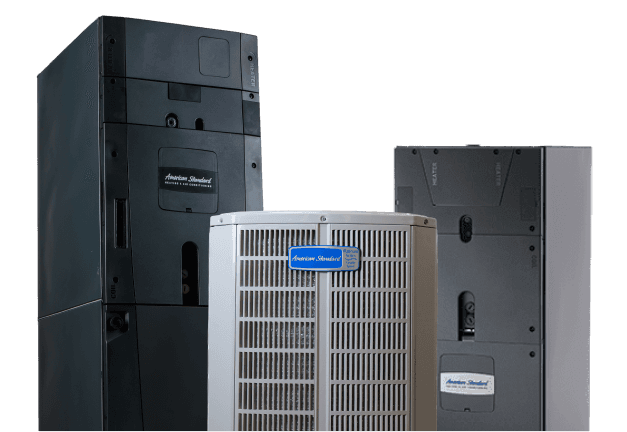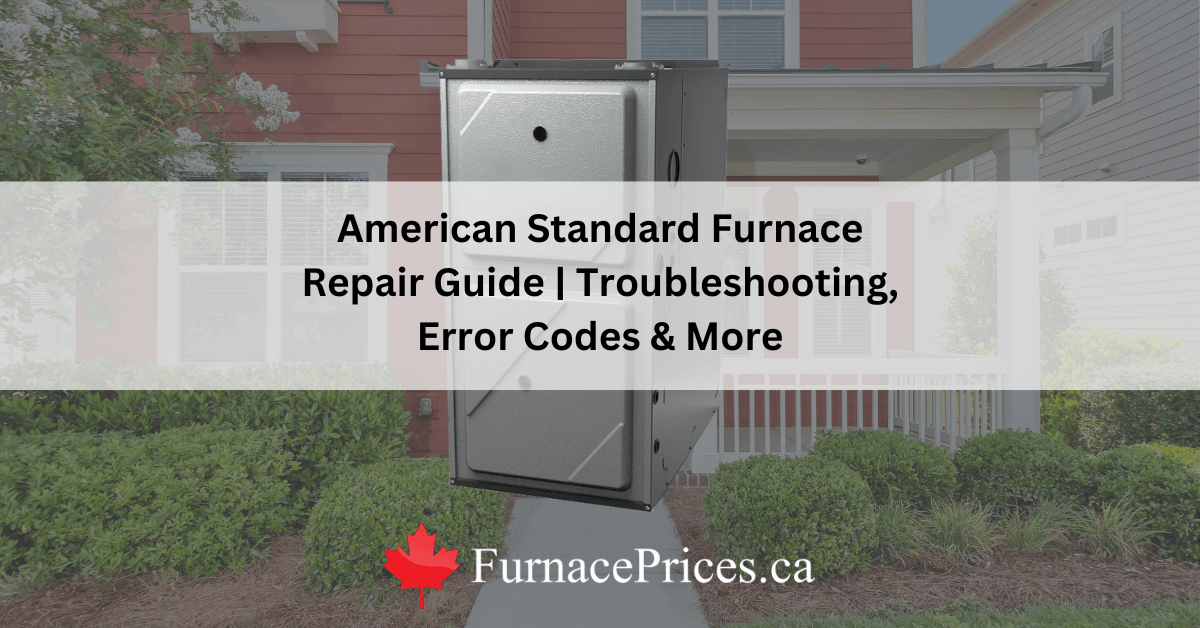Dealing with a furnace issue can be frustrating, especially in cold weather. Understanding the basics of troubleshooting can save you time and money.
American Standard furnaces are reliable, but like any equipment, they can face problems. Knowing how to troubleshoot common issues can help you keep your home warm and cozy. This guide will cover the essentials of American Standard furnace troubleshooting. We will explain simple steps to identify and fix common problems.
Whether your furnace won’t turn on, isn’t heating properly, or makes strange noises, we’ve got you covered. Let’s dive into the world of furnace troubleshooting and keep your home comfortable.
Common Furnace Issues
Experiencing issues with your American Standard furnace? You’re not alone. Furnaces can encounter various problems, especially during the cold months. Understanding common issues helps in troubleshooting and ensuring your home stays warm. Below are some frequent problems and their potential causes.
No Heat
One of the most frustrating issues is when your furnace produces no heat. Several factors can cause this:
- Thermostat Issues: Ensure your thermostat is set to “heat” and the temperature is set correctly. Sometimes, the thermostat batteries need replacing.
- Power Problems: Check if the furnace is receiving power. Inspect the circuit breaker and make sure it’s not tripped.
- Ignition Problems: Modern furnaces use electronic ignitions. If the ignition system fails, the furnace won’t start. This often requires professional assistance.
Insufficient Heat
Sometimes, your furnace may produce heat but not enough to warm your home adequately. Common causes include:
- Dirty Filters: Clogged filters restrict airflow, reducing heating efficiency. Replace filters regularly to maintain proper airflow.
- Blocked Vents: Ensure all vents are open and unobstructed. Blocked vents can prevent warm air from circulating effectively.
- Thermostat Calibration: If the thermostat is not calibrated correctly, it might not signal the furnace to produce enough heat. Calibration may be necessary.
Troubleshooting your furnace can save time and money. If these steps do not resolve the issue, consider consulting a professional. A well-maintained furnace keeps your home warm and your energy bills lower.

Credit: www.americanstandardair.com
Thermostat Problems
Is your American Standard furnace giving you trouble? Sometimes, the issue isn’t with the furnace itself but with the thermostat. Understanding potential thermostat problems can help you identify and solve issues quickly. Let’s dive into some common thermostat problems that could be affecting your furnace’s performance.
Incorrect Settings
Sometimes, the thermostat settings might be incorrect. This can lead to the furnace not heating properly. Here are some things to check:
- Temperature Setting: Ensure the thermostat is set to a temperature higher than the current room temperature.
- Mode Setting: Make sure the thermostat is set to ‘heat’ mode.
- Fan Setting: Check if the fan is set to ‘auto’ instead of ‘on’. This ensures the fan runs only when the furnace is heating.
Faulty Thermostat
A faulty thermostat can cause various issues. Here are some signs of a malfunctioning thermostat:
- No Display: If the thermostat screen is blank, it might need new batteries or be broken.
- Inconsistent Temperatures: If the room temperature doesn’t match the thermostat setting, the thermostat could be faulty.
- Unresponsive Controls: If you can’t change the settings, the thermostat might need replacement.
| Problem | Potential Cause | Solution |
|---|---|---|
| No Display | Dead batteries | Replace batteries |
| Inconsistent Temperatures | Faulty thermostat | Replace thermostat |
| Unresponsive Controls | Thermostat malfunction | Replace thermostat |
Airflow Obstructions
Airflow obstructions can cause significant issues in an American Standard furnace. These obstructions can lead to inefficient heating and increased energy costs. By identifying and addressing these issues, you can ensure your furnace operates optimally. Two common airflow obstructions are clogged filters and blocked vents. Let’s dive deeper into these problems and how to solve them.
Clogged Filters
Filters play a crucial role in maintaining clean air in your home. They trap dust, dirt, and other particles. Clogged filters restrict airflow, causing your furnace to work harder. This can lead to higher energy bills and potential damage to your system.
To prevent clogged filters:
- Check your filters every month.
- Replace them every 3 months, or as needed.
- Use high-quality filters for better performance.
Regular maintenance ensures your furnace runs smoothly.
Blocked Vents
Blocked vents are another common issue. Furniture, curtains, or other objects can obstruct vents. This blockage prevents proper airflow and disrupts heating efficiency.
To avoid blocked vents:
- Inspect all vents regularly.
- Ensure no furniture or objects cover the vents.
- Clean the vents to remove dust and debris.
Keeping vents clear ensures your furnace distributes heat evenly.
By addressing these airflow obstructions, you can improve your furnace’s efficiency and extend its lifespan.

Credit: www.furnaceprices.ca
Ignition Failures
American Standard furnaces are reliable, but sometimes they face ignition failures. This issue can disrupt your home’s comfort. Understanding common ignition problems can help you troubleshoot effectively. Let’s focus on two common issues: pilot light and electronic ignition problems.
Pilot Light Issues
Pilot lights can sometimes go out. This can be due to a clogged orifice. Dirt and debris can block gas flow. Clean the pilot orifice gently. Use a needle or compressed air. Ensure the gas valve is open. Check the thermocouple. It’s a safety device that senses heat. If the thermocouple is faulty, it won’t keep the pilot lit. Replace it if needed.
Electronic Ignition Problems
Electronic ignitions are modern and efficient. But they can fail too. A common issue is a faulty ignition control module. This module sends a signal to ignite the burner. If it fails, the furnace won’t light. Check for error codes. These codes can guide you to the problem. Another issue could be the ignitor itself. Over time, the ignitor can crack. A cracked ignitor won’t spark. Inspect it visually and replace if needed.
Blower Motor Issues
Blower motor issues can cause your American Standard furnace to malfunction. Understanding these problems helps you maintain your furnace effectively. Here, we will discuss common blower motor issues such as a blower not running and a noisy blower.
Blower Not Running
If your blower motor is not running, it could be due to various reasons. Check if the thermostat is set correctly. Ensure the furnace switch is in the “on” position. Inspect the circuit breaker to see if it has tripped. Reset it if needed. Another reason could be a blown fuse. Replace the fuse to fix the issue. Sometimes, the blower motor itself might be faulty. In that case, you may need to replace the motor.
Noisy Blower
A noisy blower can be annoying and signal a problem. The noise could be due to loose parts. Tighten any loose screws or bolts. Another reason could be a dirty blower wheel. Clean the blower wheel to eliminate the noise. Worn-out bearings can also cause noise. If this is the case, replace the bearings. Ensure the blower motor is well-lubricated. This helps in reducing noise.
Unusual Furnace Noises
Experiencing unusual noises from your American Standard furnace can be concerning. These sounds often signal that something might be wrong. Addressing these noises promptly can help avoid major issues. Let’s explore some common unusual noises and their potential causes.
Banging Sounds
Banging sounds from your furnace can be alarming. These noises typically occur due to a few common issues:
- Delayed ignition: Gas builds up in the furnace before igniting, causing a small explosion.
- Dirty burners: Debris prevents proper gas flow, leading to irregular ignition.
- Loose components: Parts within the furnace may have come loose and need tightening.
If you hear banging sounds, turn off the furnace and inspect for visible issues. Addressing these concerns quickly can prevent further damage.
Whistling Noises
Whistling noises are often caused by airflow issues. Here are some common reasons for this sound:
- Clogged filters: Dirty filters restrict airflow, causing a whistling sound.
- Closed vents: Partially or fully closed vents can create pressure imbalances.
- Air leaks: Gaps or holes in the ductwork can cause whistling noises.
To address whistling noises, check and replace filters regularly. Ensure all vents are open and inspect for any ductwork leaks.
Cycling Problems
Cycling Problems in your American Standard furnace can disrupt your comfort. These issues can cause uneven heating and increase energy bills. Understanding the difference between frequent cycling and short cycling helps in troubleshooting.
Frequent Cycling
Frequent cycling means the furnace turns on and off too often. This can wear out the system quickly. Check the thermostat settings. Incorrect settings can cause this problem. Ensure the thermostat is set to the correct mode. Clean or replace the air filter. A dirty filter restricts airflow. This can cause the furnace to overheat and shut down.
Inspect the flame sensor. A dirty flame sensor can cause frequent cycling. Clean it with a fine cloth. If the problem persists, call a professional. An expert can check for more complex issues. These may include faulty wiring or a malfunctioning limit switch.
Short Cycling
Short cycling occurs when the furnace turns on and off in short bursts. This can be due to an oversized furnace. An oversized unit heats the space too quickly and shuts down. Check the furnace size. A professional can verify if it’s the right size for your home.
Examine the ventilation system. Blockages can cause short cycling. Clear any obstructions in the vents. Another cause can be a faulty thermostat. Ensure the thermostat is functioning properly. Replace it if necessary.
Inspect the blower motor. A malfunctioning blower can cause short cycling. Listen for unusual noises. These can indicate a problem. In such cases, it’s best to seek professional help. A certified technician can diagnose and fix the issue.
Maintenance Tips
Proper maintenance of your American Standard Furnace ensures it runs efficiently. Regular upkeep can prevent unexpected breakdowns and extend the lifespan of your furnace. Below are some essential maintenance tips to keep your furnace in top shape.
Regular Inspections
Schedule regular inspections at least once a year. A professional technician can identify potential problems before they become serious. During the inspection, the technician will check the following:
- Thermostat settings
- Electrical connections
- System controls
- Condensate drain
- Heat exchanger
These checks ensure your furnace operates safely and efficiently. Don’t skip these inspections.
Cleaning Recommendations
Cleaning your furnace is crucial for its performance. Dust and debris can cause serious issues. Here are some cleaning tips:
- Clean or replace the air filter every 1-3 months.
- Vacuum the blower compartment to remove dust buildup.
- Wipe down the exterior surfaces of the furnace.
Use a soft brush to clean the vents and ducts. Make sure nothing blocks the airflow.
A clean furnace runs more efficiently and saves energy. Keep the area around your furnace clear of clutter.

Credit: www.youtube.com
Frequently Asked Questions
Why Is My American Standard Furnace Not Heating?
Check the thermostat settings. Ensure the furnace is receiving power. Check for a tripped breaker.
How Do I Reset My American Standard Furnace?
Turn off the furnace power switch. Wait 30 seconds. Turn the power back on.
What Does The Blinking Light On My Furnace Mean?
A blinking light indicates an error code. Refer to the furnace manual for specific codes.
How Often Should I Change My Furnace Filter?
Change the filter every 1-3 months. It depends on usage and filter type.
Why Is My Furnace Making Loud Noises?
Loud noises can indicate a mechanical issue. Check for loose parts or call a technician.
Conclusion
Troubleshooting your American Standard furnace doesn’t need to be stressful. Follow the steps outlined, and you’ll solve most issues. Regular maintenance ensures better performance and fewer problems. Always refer to your user manual for guidance. Seek professional help for complex issues.
Stay warm and safe!
